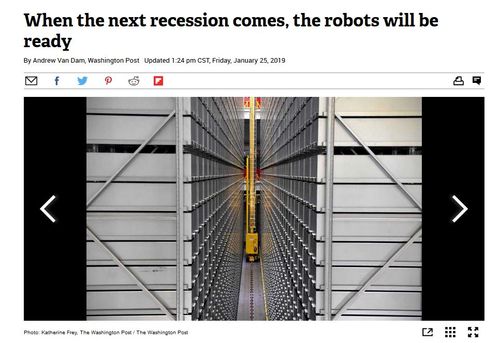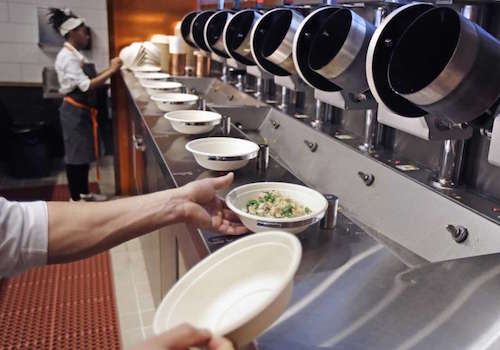


01/27/2019
It’s not news that when an economic downturn hits, business looks to cut numbers of expensive employees, but these days, the entrance of smart machines into the workplace makes the layoffs even easier for executives. It has happened before and it will happen again.
In fact, a 2013 investigation by the Associated Press found that good jobs lost in the economic downturn aren’t coming back: AP IMPACT: Recession, tech kill middle-class jobs. Companies chose to become more efficient by laying human workers off and substituting automation and software for a range of employment from farm pickers to educated office workers.
We can therefore expect similar behavior in the next recession, as is forecast in a Washington Post article, reprinted in the Houston Chronicle, linked below.
The piece utilizes the recent Brookings report, Automation and Artificial Intelligence. It presents a reassuring tone, suggesting that robots “will bring neither an apocalypse nor utopia.”
So forget about those scary predictions like the shocker on a recent Sixty Minutes show that “in 15 years, [automation is] going to displace about 40 percent of the jobs in the world.”
All in all, the best course is probably to bet on the profit urge among business executives — and when machines become cheaper than workers to perform a task, the humans will go.
The Post article observes, “Hispanic workers are more exposed than any other race or ethnic group” to the automation threat, though without connecting the educational component or ability to speak English.
Immigrants are not mentioned at all in the Brookings report, although the recent batch of illegal aliens from Honduras won’t be suitable for any useful work before too long. Foreigners whose skills consist of Third-World farming techniques will not be employable even at menial labor when the cheap robots come galloping into the workplace.
The coming automation spurt will likely bring enormous welfare costs because of crazy liberal immigration of unskilled persons.
When the next recession comes, the robots will be ready, By Andrew Van Dam, Washington Post, January 25, 2019

In this May 3, 2018, file photo a worker lifts a lunch bowl off the production line at Spyce, a restaurant which uses a robotic cooking process, in Boston. Robots aren’t replacing everyone, but a quarter of U.S. jobs will be severely disrupted as artificial intelligence accelerates the automation of today’s work, according to a new Brookings Institution report published Thursday, Jan. 24, 2019.
Robots’ infiltration of the workforce doesn’t happen gradually, at the pace of technology. It happens in surges, when companies are given strong incentives to tackle the difficult task of automation.
Typically, those incentives occur during recessions. Employers slash payrolls going into a downturn and, out of necessity, turn to software or machinery to take over the tasks once performed by their laid-off workers as business begins to recover.
As uncertainty soars, a shutdown drags on, and consumer confidence sputters, economists increasingly predict a recession this year or next. Whenever this long economic expansion ends, the robots will be ready. The human labor market is tight, with the unemployment rate at 3.9 percent, but there’s plenty of slack in the robot labor force.
This next wave of automation won’t just be sleek robotic arms on factory floors. It will be ordering kiosks, self-service apps and software smart enough to perfect schedules and cut down on the workers needed to cover a shift. Employers are already testing these systems. A recession will force them into the mainstream.
A new analysis from Mark Muro, Robert Maxim and Jacob Whiton of the Brookings Institution, a nonpartisan think tank, finds much of the nation will be susceptible to the upheaval caused by automation in coming decades, particularly young people, minorities and Rust Belt workers.
The total number of jobs will rise in the long run, but many workers will be forced to adapt. Robots will continue to roil the long-suffering manufacturing sector, Brookings finds. They will also move into low-skill service jobs such as food services workers once considered too cheap or too difficult to automate.
Economists generally focus on workers performing repetitive tasks, including rote mental or clerical work in an office cubicle and rote manual labor on a factory floor, to measure the influence of technology.
Middle-income work has evaporated in recent decades. Americans are now divided between the high-paid employees who design machines, the low-paid workers who sweeps up after it, or the even lower-paid service workers who serves fast-casual sandwiches to the other two.
In an upcoming paper from Review of Economics and Statistics, economists Nir Jaimovich of the University of Zurich and Henry Siu of the University of British Columbia found that 88 percent of job loss in routine occupations occurs within 12 months of a recession. In the 1990-1991, 2001 and 2008-2009 recessions, routine jobs accounted for “essentially all” of the jobs lost. They regained almost no ground during the subsequent recoveries.
Firms in cities hit hardest by the Great Recession raised their skill requirements for new employees and invested more in technology, according to economists Brad Hershbein of the W.E. Upjohn Institute for Employment Research and Lisa Kahn of the University of Rochester.
Their 2018 American Economic Review analysis of almost 100 million online postings collected by Burning Glass Technologies in 2007 and 2010-2015 found strong signs companies were replacing workers who performed routine tasks with a combination of technology and more skilled workers. The effect was especially pronounced for “cognitive” workers such as office clerks, office administrators and salespeople.
The economy is near full employment — the point at which everyone who wants a job has one. The unemployment rate has been at or below 4.0 percent for 10 straight months.
But the labor market for robots has room to grow. As wages rise and human help gets pricey, companies have experimented with alternatives.
The Washington Post’s Peter Holley has tapped into a deep vein of corporate automation efforts in recent months. Cooler-sized robots deliver food for $1.99 at George Mason University in suburan Washington. Tall, slim robot assistants patrol Giant supermarkets in search of spills and hazards. Walmart planned to install 360 floor-cleaning robot zambonis by the end of January. A start-up called Robomart hopes to start running mobile supermarkets in robotic minivans in the Boston area in partnership with Stop & Shop.
But while many businesses dabble, few have gone all-in — yet. (Continues)